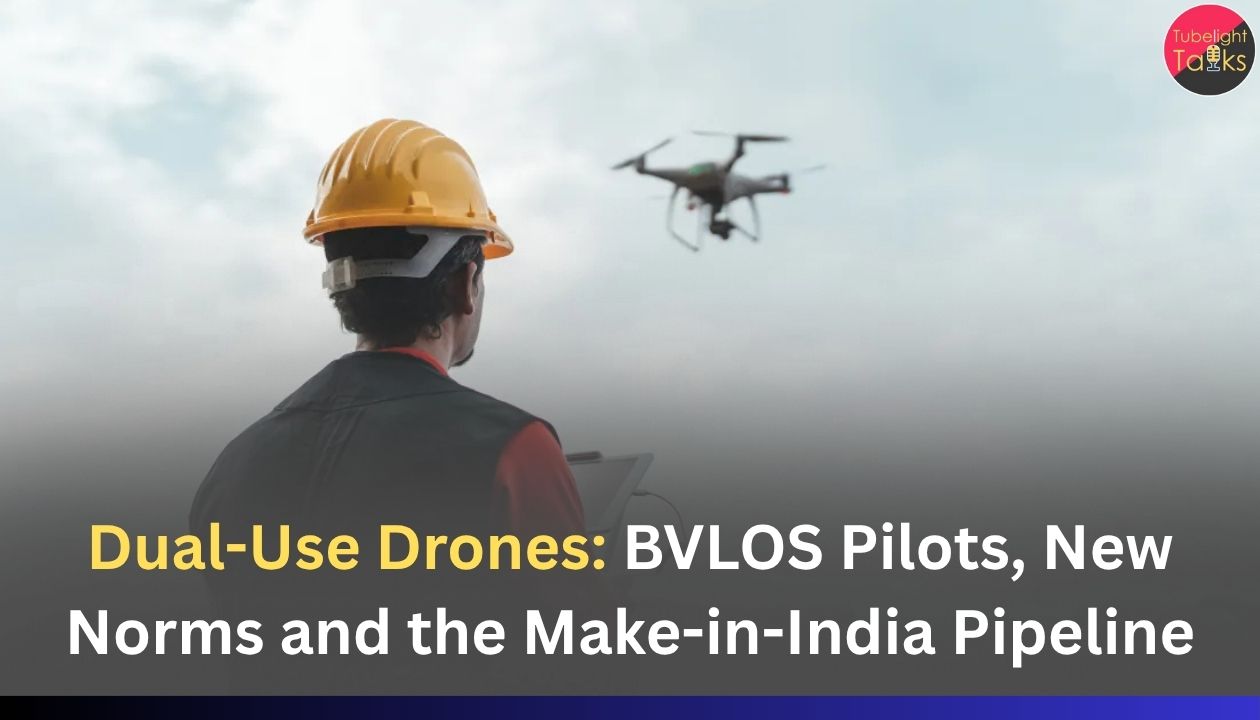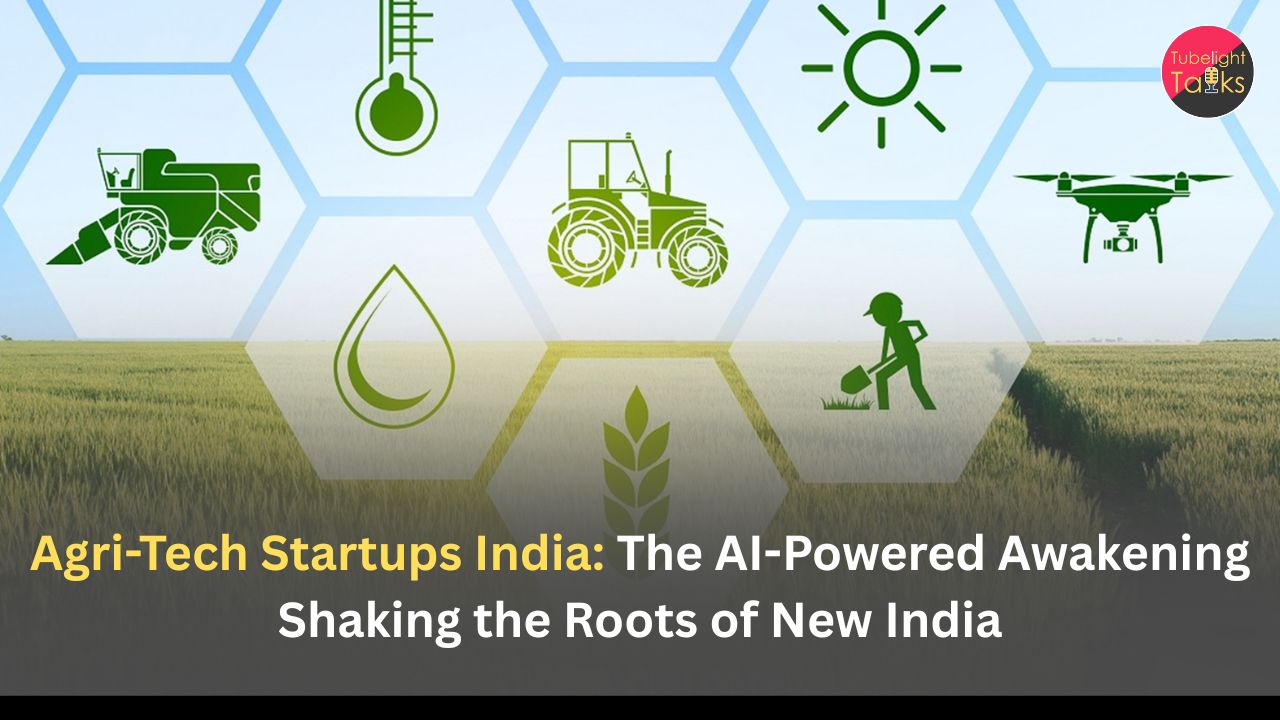Dual-Use Drones: In less than a decade, India has gone from a blanket ban on civilian drones in 2014 to positioning itself as a “global drone hub.”
On the ground, that ambition is visible in:
- BVLOS (Beyond Visual Line of Sight) medical and logistics corridors,
- A draft Civil Drone (Promotion & Regulation) Bill, 2025 meant to replace the Drone Rules 2021, and
- An aggressive Make in India push, including an import ban on foreign drones and a Production-Linked Incentive (PLI) scheme for local manufacturers.
The same airframes and avionics that deliver blood and biopsy samples today can be re-configured for border surveillance, mapping and tactical support tomorrow. This is India’s dual-use drone moment—and 2026 will be shaped by three big levers: BVLOS rules, new norms, and the manufacturing pipeline.
1. BVLOS pilots: from “Medicine from the Sky” to national corridors
Early BVLOS experiments
India’s first high-profile BVLOS efforts began with “Medicine from the Sky” in Telangana, using drones to deliver vaccines and medicines from district hubs to Primary Health Centres.
During and after COVID-19, DGCA granted conditional exemptions for multiple proof-of-concept BVLOS trials, mainly for:
- Medical supplies (blood, vaccines, diagnostics),
- Essential goods to hard-to-reach areas, and
- Asset inspection (pipelines, power lines, railways).
BVLOS in 2024–25: longer corridors, commercial pilots
By 2024–25, companies like TechEagle had moved from small trials to routine BVLOS operations:
- Meghalaya & Northeast – regular BVLOS routes delivering medicines and samples to remote health centres.
- AIIMS Guwahati – a 104 km drone delivery corridor connecting the institute to remote locations, billed as the longest corridor among AIIMS and INIs.
- Delhi-NCR – micro-corridors linking hospitals for diagnostic sample movement under controlled BVLOS conditions.
These corridors are still being flown under case-by-case exemptions and strict safety conditions—temporary patches while India waits for a formal BVLOS rulebook.
BVLOS rules “in advanced stage”
In late 2025, DGCA chief Faiz Ahmed Kidwai stated that India is “in the advanced stage of finalising BVLOS rules” for wider commercial use, especially deliveries and asset inspections.
Legal briefings expect these BVLOS norms to be tightly linked with:
- Unmanned Traffic Management (UTM) systems,
- Remote identification & tracking,
- Command-and-control link reliability, and
- Airspace zoning and geo-fencing for safety.
Until those rules are notified, BVLOS remains a privilege granted via exemptions, not a standard license path—a key bottleneck for scale.
2. New norms: from Drone Rules 2021 to the Civil Drone Bill 2025
Drone Rules 2021 + amendments: the current base
For now, operators still fly under the Drone Rules, 2021, as amended in 2022–23. These rules:
- Classify drones by weight (nano to large) and require registration + UIN for most UAS,
- Mandate remote pilot licences for non-nano drones used commercially or BVLOS,
- Enforce geo-fencing, no-fly zones and altitude caps, and
- Lay the foundation for insurance and safety obligations.
Draft Civil Drone (Promotion & Regulation) Bill, 2025: continuity with teeth
On 16 September 2025, the Ministry of Civil Aviation released the Draft Civil Drone (Promotion & Regulation) Bill, 2025 for consultation. The Bill aims to create a standalone law for civil drones under 500 kg and eventually replace Drone Rules 2021 and their amendments.
Key features highlighted by legal analyses:
- Mandatory type certification for every drone (with limited exemptions), tying certification directly to safety and security features.
- A clear mandate that no drone can operate without registration + UIN from DGCA.
- Explicit powers for government to ban import or export of any class of UAS when necessary.
- Stronger enforcement provisions—tampering with safety features or violating restrictions can attract higher penalties and even imprisonment.
Critics warn that the Bill marks a shift from a relatively “light-touch” 2021 regime to a stricter licensing culture, possibly increasing compliance burden for startups and smaller operators.
Tensions: hobbyists vs industrial scale
One unexpected flashpoint is aeromodelling. The Indian Aeromodellers Association (IAMA) has publicly argued that clubbing aeromodels with drones—subjecting them to full registration, licensing and penalties—could kill a century-old educational hobby, and has urged the government to carve out lighter norms for non-commercial model aircraft.
This debate matters for dual-use too: overly broad rules can accidentally stifle innovation pipelines (skills, hobby projects, early-stage prototypes) that feed both civil and defence applications.
3. The Make-in-India pipeline: import bans, PLI and dual-use OEMs
Import ban with component liberalisation
Since February 2022, India has banned the import of fully built foreign drones in CBU/SKD/CKD form, with narrow exceptions for defence, R&D and security. Imports of components, however, have been liberalised.
The goal, reiterated by the current Civil Aviation Minister, is to force localisation of airframes and avionics and promote domestic startups instead of importing off-the-shelf foreign platforms.
PLI + policy stack
On top of this, India has rolled out a PLI scheme for drones and drone components, and is considering extending and linking it more strongly to R&D and indigenisation targets.
Taken together with:
- Reduced GST on drones and parts, and
- Government tenders in agriculture, mapping and deliveries,
…this creates a pipeline of demand for Indian OEMs across civil and defence use cases.
Dual-use OEMs: one platform, many missions
Case studies like ideaForge illustrate how Indian drone manufacturers often start with defence and internal security contracts (ISR, surveillance, mapping) and then build civil variants for sectors like:
- Infrastructure inspection (roads, rail, power lines),
- Agriculture (spraying, crop-health mapping),
- Mining and land survey (GIS, photogrammetry), and
- Logistics & medical supply (smaller fixed-wing or multi-rotor platforms).
With BVLOS rules coming and the Drone Bill tightening norms, these same OEMs sit at the core of India’s dual-use pipeline:
One stack of airframes, avionics and ground control → multiple payloads and missions → both civil revenue and strategic capability.
4. Risks and bottlenecks: BVLOS friction, over-regulation, and UTM gaps
Despite momentum, three constraints could slow India’s dual-use drone ambitions:
- BVLOS uncertainty
- Until DGCA formally notifies BVLOS rules, every long-range operation depends on exemptions, making scaling and fundraising harder for logistics and inspection players.
- Until DGCA formally notifies BVLOS rules, every long-range operation depends on exemptions, making scaling and fundraising harder for logistics and inspection players.
- Regulatory overreach risk
- The Draft Drone Bill’s blanket approach (from hobby clubs to freight corridors) may raise costs and complexity without proportionate safety gains—something industry bodies and hobby groups are already flagging.
- The Draft Drone Bill’s blanket approach (from hobby clubs to freight corridors) may raise costs and complexity without proportionate safety gains—something industry bodies and hobby groups are already flagging.
- UTM and airspace integration
- Large-scale BVLOS will need robust UTM systems, remote ID and geo-fencing, integrated with ATC. Indian policy papers acknowledge this, but implementation is nascent.
- Large-scale BVLOS will need robust UTM systems, remote ID and geo-fencing, integrated with ATC. Indian policy papers acknowledge this, but implementation is nascent.
How India manages these three will decide whether dual-use drones truly “soar” in 2026—or remain stuck in pilots and policy drafts.
Dharma and dual-use technologies
From a Satgyan lens inspired by Sant Rampal Ji Maharaj, dual-use drones are not just a tech or industrial-policy question – they’re also about Dharma (righteousness) – Drones that serve only elite logistics or military contracts, while rural areas lack basic services, reflect a skewed priority. Dharmic planning would prioritise healthcare corridors, disaster relief, crop insurance assessments and environmental monitoring alongside strategic uses, so that villagers and vulnerable communities also gain from the technology.
Norms must be clear about where drones are used, what data they capture (imagery, mapping, telemetry), and how that data is stored or shared. Hidden surveillance or opaque data monetisation is fundamentally adharmic, even if technically legal. The same drone that carries blood to a remote PHC can be weaponised elsewhere in the world. Satgyan reminds policymakers that moral restraint and international norms are essential so that India’s Make-in-India success does not feed cycles of violence or misuse.
Read Also: Green Technology: How Innovation Is Saving Our Planet
FAQs: Dual-use Drones in India
1. What are “dual-use” drones in India?
Drones usable for both civilian tasks and defence roles by changing payloads or software, while using the same core airframes and avionics.
2. Are BVLOS drone operations fully legal today?
Not yet. BVLOS flights run under DGCA exemptions and pilots; final BVLOS rules are in advanced stages and expected to enable routine operations.
3. What does the Draft Civil Drone Bill 2025 change?
It creates a standalone drone law, mandates certification/registration, strengthens safety features, and adds stricter penalties. It’s still open for feedback.
4. How is the import ban linked to Make in India?
India bans fully built foreign drones but allows components, promoting domestic manufacturing alongside PLI incentives.
5. Why are aeromodellers protesting the draft bill?
They say hobby aero-models are treated like commercial drones, risking educational and recreational flying without clear exemptions.










